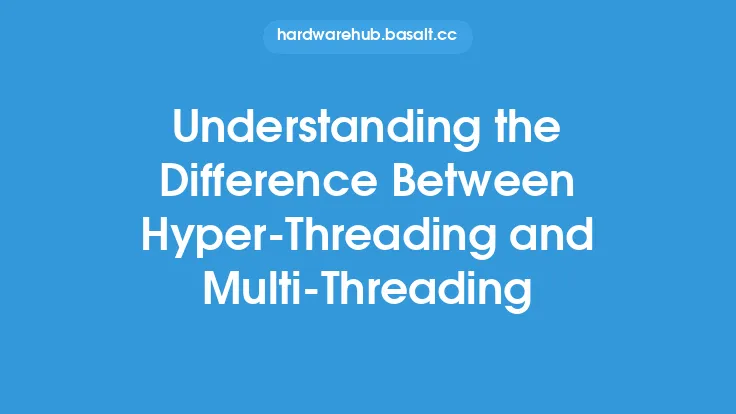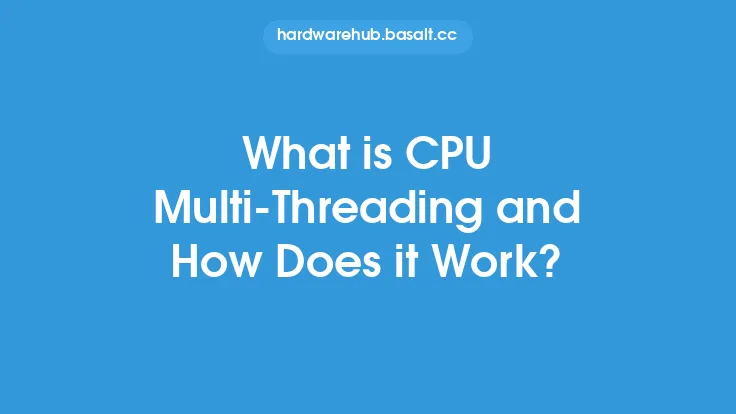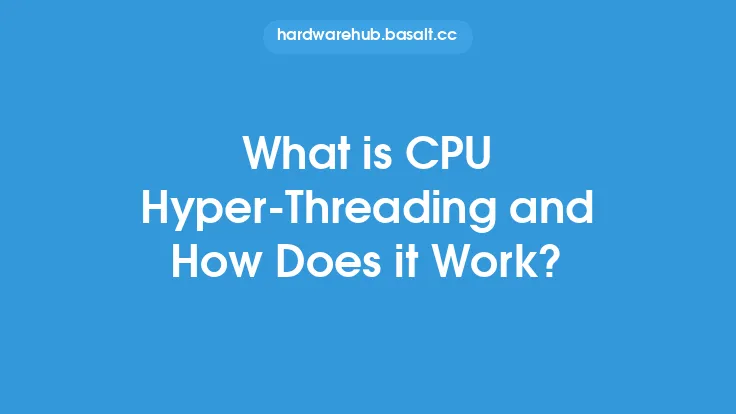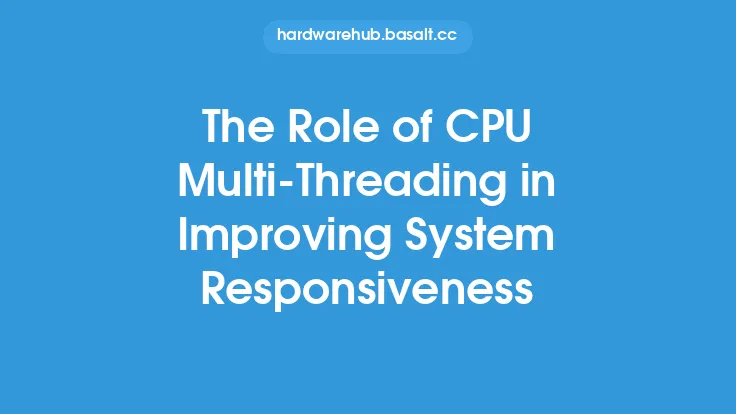When it comes to computer processing, one of the most important components is the Central Processing Unit (CPU). The CPU is responsible for executing instructions and handling tasks, and its performance can greatly impact the overall speed and efficiency of a computer system. In recent years, CPU manufacturers have developed various technologies to improve CPU performance, including multi-threading and Hyper-Threading. While these terms are often used interchangeably, they actually refer to different concepts.
Introduction to CPU Multi-Threading
CPU multi-threading is a technique that allows a single CPU core to execute multiple threads or processes simultaneously. This is achieved by dividing the CPU's execution resources, such as registers and execution units, among multiple threads. Each thread is executed in a time-sliced manner, with the CPU switching between threads quickly to minimize overhead. This allows a single CPU core to handle multiple tasks concurrently, improving overall system responsiveness and throughput.
What is Hyper-Threading?
Hyper-Threading, on the other hand, is a specific implementation of multi-threading technology developed by Intel. It allows a single CPU core to appear as multiple logical processors to the operating system, enabling it to execute multiple threads simultaneously. Hyper-Threading uses a technique called simultaneous multi-threading (SMT), which allows multiple threads to share the same execution resources, such as registers and execution units. This allows for improved CPU utilization and increased throughput, especially in applications that are heavily multi-threaded.
Key Differences Between CPU Multi-Threading and Hyper-Threading
While both CPU multi-threading and Hyper-Threading enable a single CPU core to execute multiple threads simultaneously, there are key differences between the two. CPU multi-threading is a general term that refers to the ability of a CPU to execute multiple threads concurrently, whereas Hyper-Threading is a specific implementation of multi-threading technology developed by Intel. Additionally, Hyper-Threading uses SMT to allow multiple threads to share the same execution resources, whereas CPU multi-threading can use various techniques, such as time-slicing or hardware-based threading.
How CPU Multi-Threading and Hyper-Threading Work
To understand how CPU multi-threading and Hyper-Threading work, it's essential to delve into the details of CPU architecture. A CPU core consists of several components, including execution units, registers, and a control unit. Execution units, such as arithmetic logic units (ALUs) and floating-point units (FPUs), perform the actual computations. Registers store data temporarily while it's being processed, and the control unit manages the flow of instructions and data.
In a multi-threaded CPU, each thread is assigned a separate set of registers and execution units. The CPU switches between threads quickly, executing a few instructions from one thread before switching to another. This allows multiple threads to be executed concurrently, improving overall system responsiveness and throughput.
Hyper-Threading, on the other hand, uses SMT to allow multiple threads to share the same execution resources. Each thread is assigned a separate set of registers, but they share the same execution units. The CPU switches between threads quickly, executing a few instructions from one thread before switching to another. This allows for improved CPU utilization and increased throughput, especially in applications that are heavily multi-threaded.
Benefits of CPU Multi-Threading and Hyper-Threading
Both CPU multi-threading and Hyper-Threading offer several benefits, including improved system responsiveness, increased throughput, and better multitasking capabilities. By allowing multiple threads to be executed concurrently, CPU multi-threading and Hyper-Threading can improve overall system performance, especially in applications that are heavily multi-threaded.
Additionally, CPU multi-threading and Hyper-Threading can help improve system responsiveness by allowing the CPU to switch between threads quickly. This can improve the overall user experience, especially in applications that require rapid responses to user input.
Limitations of CPU Multi-Threading and Hyper-Threading
While CPU multi-threading and Hyper-Threading offer several benefits, they also have some limitations. One of the main limitations is that they can increase power consumption and heat generation. This is because the CPU is executing multiple threads concurrently, which can increase the overall power consumption and heat generation.
Another limitation is that CPU multi-threading and Hyper-Threading can be sensitive to the type of workload. For example, applications that are heavily multi-threaded can benefit from CPU multi-threading and Hyper-Threading, but applications that are single-threaded may not see any benefits.
Conclusion
In conclusion, CPU multi-threading and Hyper-Threading are two related but distinct concepts in computer processing. While both enable a single CPU core to execute multiple threads simultaneously, they differ in their implementation and benefits. CPU multi-threading is a general term that refers to the ability of a CPU to execute multiple threads concurrently, whereas Hyper-Threading is a specific implementation of multi-threading technology developed by Intel. By understanding the differences between CPU multi-threading and Hyper-Threading, users can better appreciate the benefits and limitations of these technologies and make informed decisions when selecting a CPU for their computing needs.





